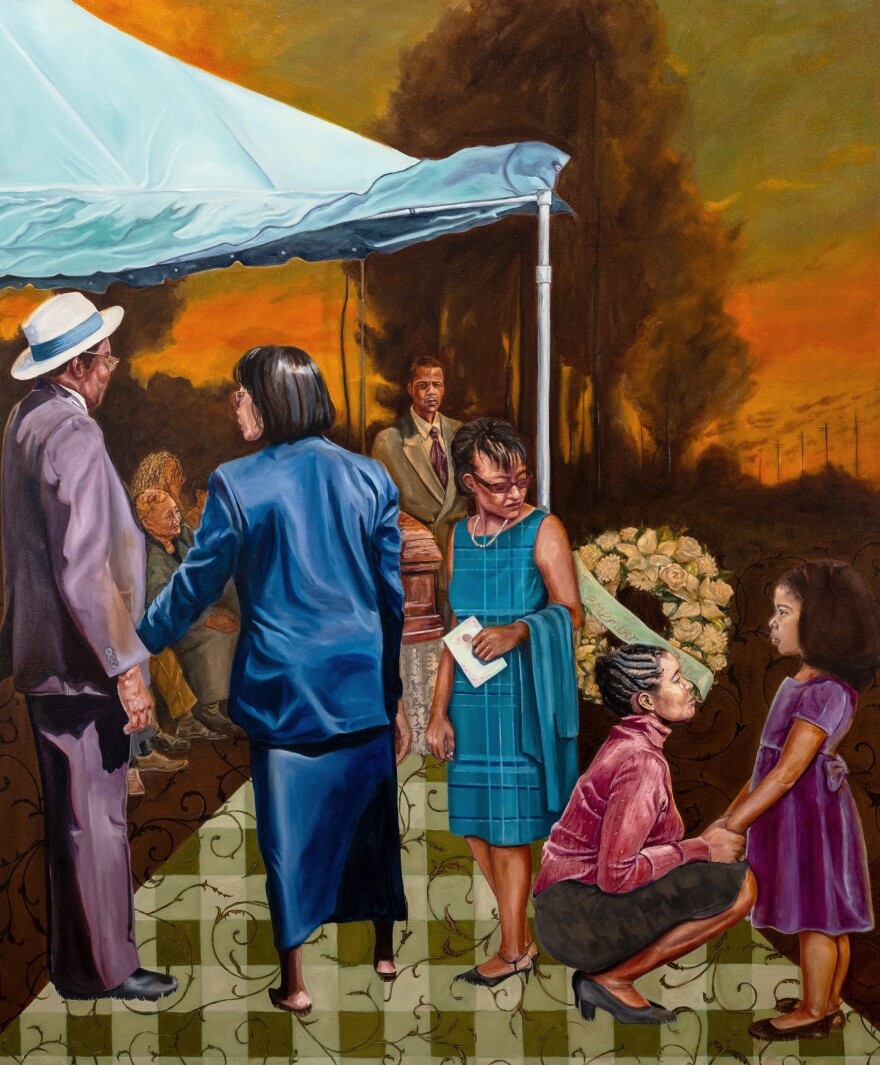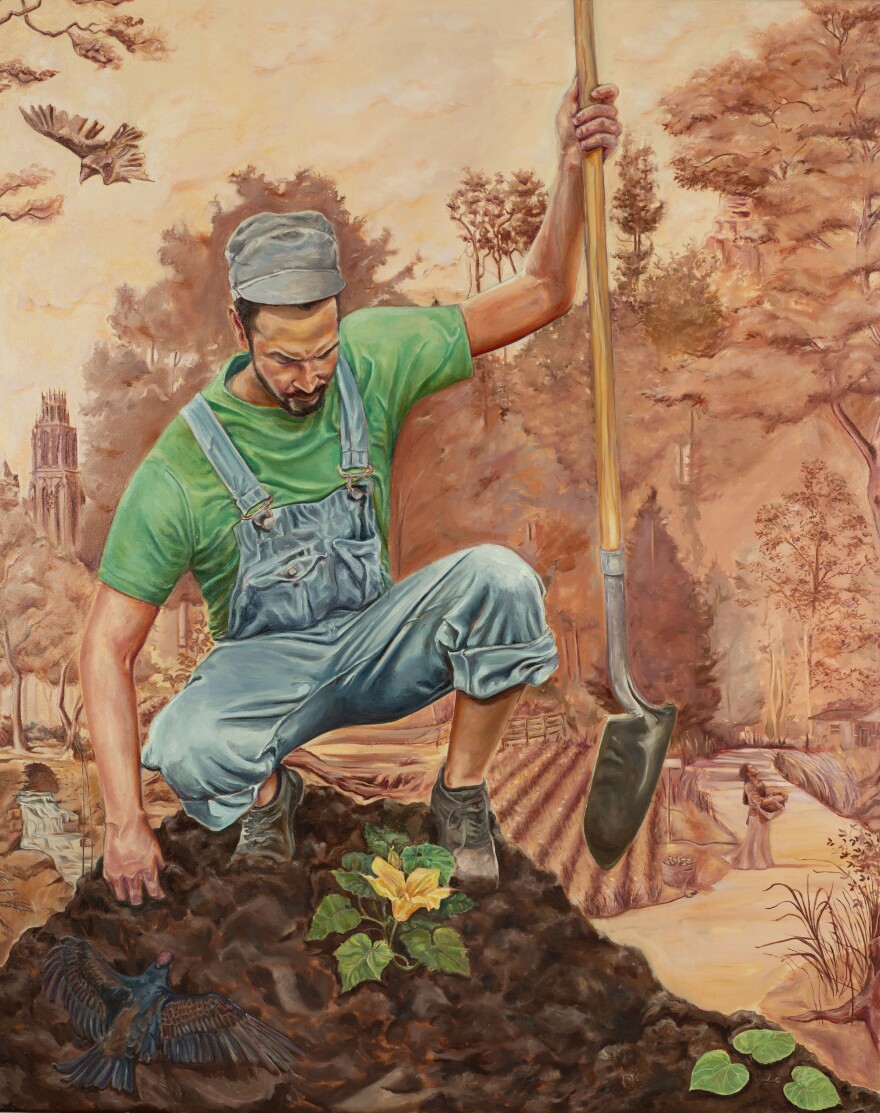Atlanta-based artist Ayana Ross uses her art to tell stories of everyday people doing everyday things, while exploring racial, social and historical issues.
Ross began her career in fashion design, but after going through a divorce, she turned to art full time. She said it helped her survive personal challenges and loss. A figurative painter, Ross, has won national awards including the Bennett Prize and the Eben Demarest Award. Her exhibition, “When Two or More Are Gathered," can be seen at UNC Charlotte Center City’s Projective Eye Gallery. She tells WFAE's Gwendolyn Glenn that American painter Norman Rockwell, also known for portrayals of everyday moments in American life — is a major influence on her work.

Ayana Ross: Initially, it was not necessarily intentional. And more recently, in recent years, I've definitely been leaning into that a lot more — particularly his process. Like Rockwell, I will gather photos of people, sometimes posing for me, the way that he would have a lot of the people in his community pose. But I will also just go out and gather pictures at the grocery store, or ask parents at a school if I can take pictures of their children. You know, things like that. Or even inviting people to the studio to help me recreate a particular scene, and then taking those images and kind of infusing them into whatever setting I need to reinforce the narrative. That's what I mean by his process.
Gwendolyn Glenn: Looking at the exhibition at UNC Charlotte, one that caught my eye especially was one of the two women. One woman is doing the hair of the other, and they're on a couch. What influenced that?
Ross: It stemmed from a photo I found of my mother and my aunt when they were younger. I have a book where I keep all of these images, and I wait for it to mean something to me. And then I will go about telling a bigger story.
So, when I started the piece, I had just returned home after a fellowship at Yale, and I was particularly tired — all the demands that were hitting me upon my return, you know? Because I am a mother of four, and I knew that I needed to take some time to rest. And I thought about what that meant for me, and I thought about what it would mean for my ancestors to rest, and I recalled that image.
Now, the painting is much more than what the photo was, so I had people pose for me a little bit to help me get some of those details, like the folds in the pants — and I think those are even my hands — and I incorporated that picturesque landscape in the background.
It's very tiny, but includes an image of my great-grandmother sitting in a rocking chair. It's just a reminder, like when I rest, I rest for everyone. I rest for them. I rest for my children, to show them how to rest. So that's what birthed that entire painting.

Glenn: That's a great story. I've read in many places where you're described as a figurative artist. Why figures?
Ross: For me, that's just been the easiest way for me to tell a story. I have always been interested in drawing and depicting the human figure, as early as I can remember.
When I was little, living in the Deep South out in the country, I had a three-ring binder, and I walked around drawing people. So that's just something that's always been with me when I wanted to express something. Figures, for me, were the best way to do it.
Glenn: Now, getting back to "When Two or More Are Gathered," in the painting of the funeral scene, there was one woman who was looking down at the little girl, and she had an expression that my eyes went to immediately. What's behind that expression?

Ross: The piece that you're referring to is titled "Remember Me." You see a lot of older people kind of seated, and the woman that's speaking to a little girl — she's the little girl's mother in my mind.
The concept came to me, really, when I had quite a bit of loss in the family. And what I was thinking about was the fact that when we lose our elders, it is really important that we continue to share the stories that they held. In the painting, the mother is telling the child all of these things. And the woman that you're referencing — she’s just kind of looking back and saying, ‘Make sure you tell it right, you're passing on truth.’
Glenn: The painting captures that so well. So, with the change in the climate in the country, lots of chaos, is that affecting your work and the subjects that you are putting on canvas?
Ross: Absolutely. There's a painting in the show that shows this family in an outdoor gathering, and they're all kind of looking in one direction with their arms crossed — like waiting with bated breath to see what's happening.
With that painting, I started with one intent. I was trying to wrap it up right around the elections in November. I just could not move forward, so with that piece, instead of trying to force it to be what I intended it to be, I decided to let it be — because that is exactly where I was. I just felt like I'm watching and waiting, questioning, concerned, and so I just let it be.
But yes, certainly, I pay attention. I feel like that's my responsibility, and my obligation to the work is to pay attention to what's happening in the world and offer my perspective.

Ayana Ross is a figurative oil painter. Her exhibition, "When Two or More Are Gathered," can be seen through April 7 at UNC Charlotte Center City’s Projective Eye Gallery.


